The Battle of Boyra was a ground and aerial battle that was fought on 22 November 1971 between the India and Pakistan.
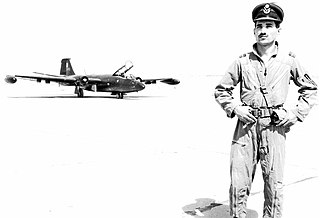
Najeeb Ahmad Khan, commonly known as 8-Pass Charlie, was a Pakistani bomber pilot who raided the Adampur Airbase in India a number of times during the Indo-Pakistani War of 1965, notably starting a series of airstrikes on the base by a solo raid.
The Hilal-e-Jurat is the second-highest military award of Pakistan out of a total of four gallantry awards that were created in 1957. In order of rank it comes after the Nishan-e-Haider coming before the Sitara-e-Jurat.
Sitara-e-Jurat is the third highest military award of Pakistan. It was established in 1957 after Pakistan became a republic; however, it was instituted retrospectively back to 1947. It is awarded for gallantry or distinguished service in combat; and can be bestowed upon officers, junior commissioned officers, petty officers, warrant officers, soldiers, sailors, airmen, and equivalents in the Pakistan Army, Navy, Air Force, and various paramilitary forces under federal control, such as the Frontier Corps, the Frontier Constabulary, and the Pakistan Rangers. It may be considered to be roughly equivalent to the Military Cross and the Silver Star.

During the Indo-Pakistani war of 1965, the Indian and Pakistani Air Forces engaged in large-scale aerial combat for the first time. In the air war, which took place in September, both air forces conducted thousands of defensive and offensive sorties over Indian and Pakistani airspace. Both India and Pakistan claimed victory in the air war; Pakistan claimed to have destroyed 104 Indian aircraft and lost 19, and India claimed to have destroyed 73 Pakistani aircraft and lost 35 of its own. The air war ended in a stalemate.
Wing Commander Mervyn Leslie MiddlecoatSJ & Bar was a Pakistani fighter pilot in the Pakistan Air Force (PAF) who was involved in a number of aerial battles during the 1965 and 1971 Indo-Pakistani wars, before being shot down on 12 December 1971. He was one of a number of distinguished Pakistani strike and fighter pilots of the period. Before his death he was stationed at Mauripur, Karachi, Pakistan where he flew the F-104 Starfighter.
Air Commodore Abdus Sattar Alvi, SJ, SI(M), is a retired one-star rank air officer and a fighter pilot in the Pakistan Air Force, who is renowned for his gallant actions during the third Indo-Pakistani in 1971, and served as a military advisor in the Syrian Air Force during the Yom Kippur War of 1973.

Squadron Leader Peter Christy, SJ, was a PAF bomber pilot and weapon systems officer (WSO). A B-57 Canberra navigator, Squadron Leader Christy was officially declared "missing in action" since December 1971, but widely presumed dead by the Pakistan Armed Forces as of 2004.
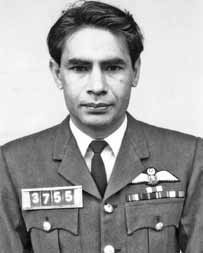
Syed Manzoor ul Hassan Hashmi was squadron leader in the Pakistan Air Force. He served in the 1965 and 1971 wars. He was a recipient of the Sitara-e-Jurat.
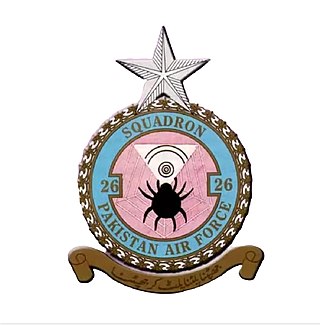
The No. 26 Squadron, nicknamed the Black Spiders, is a multi-role squadron of the Pakistan Air Force's Northern Air Command. It is currently based at Peshawar Airbase and operates the PAC JF-17 Thunder multirole fighter jets.

Saiful Azam (Bengali: সাইফুল আজম; was a Pakistani, and then Bangladeshi fighter pilot, ace, and politician who first served as a fighter pilot for the Pakistan Air Force and later the Bangladesh Air Force. According to Pakistani sources, during his career as PAF pilot, he shot down one Indian Air Force and four Israel Air Force aircraft. For his actions, he received various gallantry awards from Pakistan, Jordan and Iraq. He also took part in 12 ground-attack missions against the Indian forces. After the liberation of Bangladesh, he joined the newly formed Bangladesh Air Force.

Samad Ali Changezi was a Flight lieutenant in Pakistan Air Force who fought in the Indo-Pakistani War of 1971. He belonged to the Hazara ethnic minority of Quetta, Pakistan and was a member of the No. 9 Squadron – the Pakistan Air Force's first fighter squadron. He remains among the few confirmed aerial combat casualties involving the Lockheed F-104 Starfighter.
Air Commodore Imtiaz BhattiSJ SI(M) SBt in Gujrat, British India, is a cyclist and a former Air Force pilot of Pakistan. He was the Pakistan cycling champion during his student days at Punjab Agriculture College, Lyallpur in late 1940s and early 1950s. He set national cycling records and represented Pakistan in the individual and team road race events at the 1952 Summer Olympics where he was placed 1st among the Asian cyclists and 25th in the world in the 1000 m time trial. Bhatti a veteran of the Indo-Pakistani War of 1965 flew 34 combat missions, the maximum from Pakistan during the war and is credited with confirmed downing of two Indian planes and damaging a third, in addition to participating in raids that destroyed the Amritsar radar and various other air defence and ground support missions.
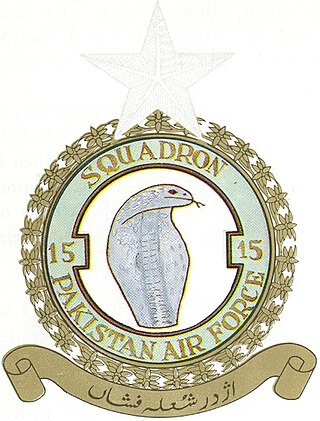
The No. 15 Squadron, nicknamed Cobras, is a tactical attack squadron of the Pakistan Air Force (PAF). The Squadron is currently based at PAF Base Minhas in Kamra, Punjab, Pakistan and equipped with Chengdu J-10C multirole fighter jets. The Squadron also carries the honour of achieving the first kill for the PAF.
No. 8 Squadron, nicknamed the Haiders, is a tactical attack squadron from the No. 32 TA Wing of the Pakistan Air Force's Southern Air Command. It is currently deployed at Masroor Airbase and operates the JF-17A Multi-role fighter.

The No. 14 Squadron, nicknamed Tail Choppers, is an air superiority squadron of the Pakistan Air Force's Central Air Command. It is one of PAF's most decorated squadrons which earned its nickname after a daring strike mission on the Kalaikunda Air Force Station during the 1965 War. Currently, the Squadron is deployed at PAF Base Rafiqui and operates the PAC JF-17 Thunder multirole aircraft.
The No. 25 Squadron, nicknamed Eagles, is a tactical attack squadron from the No. 34 Wing of the Pakistan Air Force's Central Air Command. It is currently deployed at Rafiqui Airbase and operates ROSE upgraded Dassault Mirage-5EF aircraft.

The No. 23 Squadron, nicknamed Talons, is an air superiority fighter squadron of the Pakistan Air Force. It is based at PAF Base Samungli in the Balochistan province of Pakistan and operates the Chengdu F-7PG aircraft.
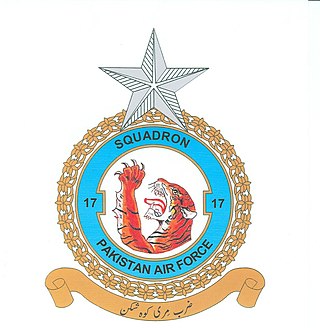
The No. 17 Squadron nicknamed Tigers, is an air superiority squadron of the Pakistan Air Force's Northern Air Command. It is currently deployed at Peshawar Air Base and operates the Chengdu F-7PG aircraft.

Flight Lieutenant Yunus HussainSJ was a Pakistan Air Force officer who shot down 2 Hawker Hunters, one being flown by F/O AR Gandhi of the Indian Air Force over Halwara. Shortly after, Yunus was shot down in the same area by F/L Vinod Neb after making a mistake by turning to the left into Nebs range. He is considered one of the greatest war heroes of Pakistan during the Indo-Pakistani War of 1965. Yunus Hussain received the green endorsement award twice from C-in-Chief Pakistan Air Force Asghar Khan. This recognition was in honor of his passion for flying, which led him to achieve the fastest 500 and then 1000 flying hours in the PAF.














